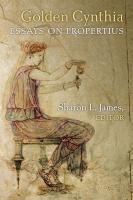
Michigan 2022 h/b 244p £63 (ISBN 9780472133246)
Golden Cynthia contains a series of essays written in homage to the work of the late Barbara L. Flaschenriem, associate professor emerita of Classics at Grand Valley State University, who at the time of her death had completed only two chapters of her projected work on Dream and Ecphrasis in Roman Elegy. These form the first essays of the book, accompanied by five further contributions displaying a variety of approaches on topics that range over all four books of Propertius’ elegies. All source material is translated into English and a list of scholarly works cited is appended to each essay.
Chapter 1 deals with poems 1.3. and 2.29a and b, showing how the narrator responds to his mistress as if she were a work of art, presented in an ecphrasis or dream vision. He desires intimacy with her, but while asleep, she remains indifferent to his erotic fantasies. Once awake however, she quickly disrupts his reveries, and her words allow insight into her own experience of their love affair.
Chapter 2 focuses on poems 3.3. and 4.7 with their lengthy dream visions. Poem 3.3 employs ecphrastic elements from wall painting and garden design in an evocation of the home of the Muses, where the poet is advised not to attempt the composition of epic but to continue writing love poetry. Poem 4.7 contains a description of the dead Cynthia appearing in a dream, where she once again offers her view of their relationship, composing her own epitaph and dictating the form of her grave monument with her own authoritative voice, thus becoming the aurea Cynthia of the book title, who combines the beauty of Venus with the dignity and reserve of chaste Diana.
In Chapter 3 Andrew Feldherr explores the painterly elements of poem 2.12, contrasting the artist’s static image of Cupid in the Temple of Apollo Palatine with the poet’s ability to set this figure in motion and thus surpass the art of the painter. Propertius constructs an image of the poet as lover, while Cynthia becomes a statue as well as an artist, both the poet’s inspiration and a figure crafted by his art.
Ellen Greene in Chapter 4 discusses the subject of sex and violence in Propertius Book 2, exploring the interplay in Propertius between the traditional elegiac themes of love and war, epic and elegiac poetry. She proposes a new definition of Roman masculinity, using poem 2.12 as a case study to demonstrate the complex relationship between the poet-lover and the elegiac puella, and the transcendent power of poetry to surmount the constraints of time and mortality.
In Chapter 5 Lowell Bowditch’s post-colonial study examines poems 2.3 and 1.11 and 12 in the light of Rome’s imperial expansion, eroticising foreign lands as places of seductive mystery awaiting masculine conquest, like the elegiac mistress who, in her desire for luxury goods and mastery of exotic artistic skills, can be conquered by men, but also wields her own imperium. This is shown to image the ambivalent relationship of Rome with Greek culture which Rome has absorbed and adapted, but which still threatens to corrupt Roman cultural values.
In Chapter 6 Alison Keith demonstrates Propertius’ familiarity with Virgil’s unfinished Aeneid, the poet not merely quoting it extensively in his fourth book of elegies, but also engaging with its themes, particularly Virgil’s treatment of the Battle of Actium and the Hercules and Cacus episode in Aeneid 8. The programmatic poem 4.1 begins with Aeneid 8’s opposition of ancient and contemporary Rome and goes on to allude to the Trojan themes of Aeneid 2. Although the seer, Horos, appears to warn the poet away from Virgil’s epic domain, every elegy in Book 4 adapts material from the Aeneid to create a new form of elegiac poetry combining Alexandrian artistry and erudition with greater historical and political engagement.
In the final essay Sharon L. James, the volume’s editor, shows that what Propertius teaches his pupil, the ‘attentive reader’, is how to read his poetry discerningly. She demonstrates that by careful re-reading of the poet’s whole corpus, one can detect an extensive web of repetitions of language, themes and motifs in the tightly woven structure of Propertius’ poetry, in which many poems of Books 1-3 link back to poem 1.1 and Book 4 offers a wholesale revision of Books 1-3, often undercutting with humour the poet’s previous assertions.
This is a volume for serious students and scholars of Propertius and elegiac poetry and its place is in the academic library.
Claire Gruzelier
